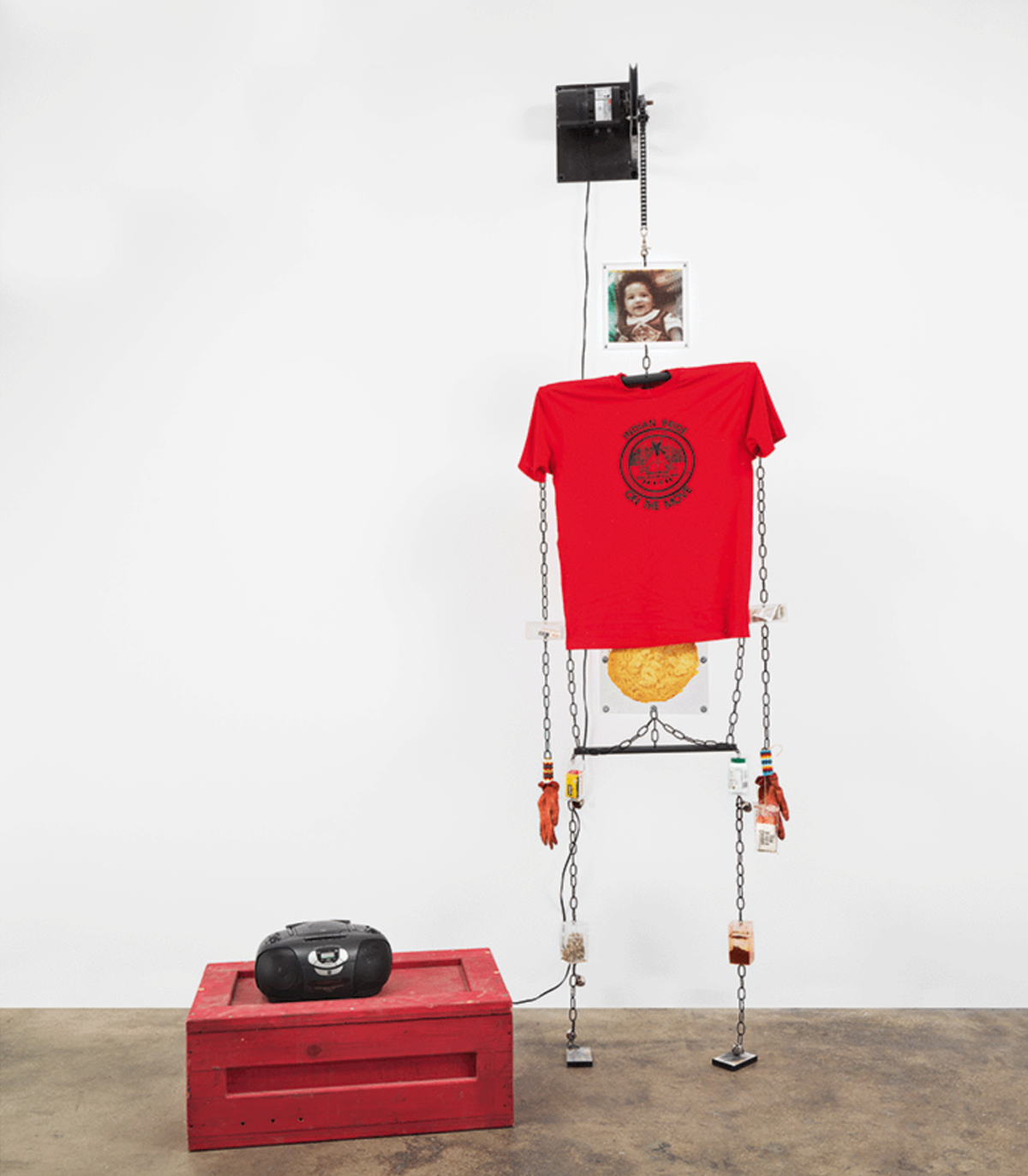Memory Map Smartphone Tour: Warrior for the 21st Century

In Warrior for the 21st Century (1999), a figural sculpture periodically dances to the sound of a rattle while an unidentified voice counts to 10 in the Salish language. To create this work, Jaune Quick-to-See Smith collaborated with her son and fellow artist Neal Ambrose-Smith. The sculpture is constructed by objects including an electronic motor, metal chains, steel, deck of cards, fry bread, aspirin, cassette tapes, echinacea, and more. All of these elements, Ambrose-Smith notes, are objects “every warrior needs.”
The artists created this sculpture to reflect serious issues affecting contemporary Native Americans, and armed their warrior with items for facing the challenges of the new millennium. Included are red ochre and sage for ceremonies, as well as the Indian AIDS Hotline telephone number (an important resource given the growing rates of HIV and AIDS in Indigenous communities in the late 1990s, when this work was made). The warrior also carries a copy of the 1855 Treaty of Hellgate, which established the reservation lands of the Confederated Salish and Kootenai Nation, where Smith was born and returns to often. The treaty serves as a reminder of past struggles with the federal government and the limitations of working within a colonial legal structure to protect land, water, and resources.
Learn more about Warrior for the 21st Century from Ambrose-Smith by tuning in to the free smartphone tour of Jaune Quick-to-See Smith: Memory Map at SAM. Produced by the Whitney Museum of American Art, the tour can be accessed online via our SoundCloud or by scanning the QR codes positioned next to select works on view in the exhibition. Memory Map closes in less than one month at SAM. Don’t miss out: reserve your tickets to see it at SAM before it’s too late.
Warrior for the 21st Century, 1999
NARRATOR: In 1999, Smith was commissioned to make a work that could be packed into a small box–a time capsule. Working on the project with her son, Neal Ambrose-Smith, she set out to make the work take up as much space as possible when it was removed from its container.
NEAL AMBROSE-SMITH: And so this, the idea was born of maybe a figure and then it could dance or move. And it could be animatronic.
NARRATOR: Neal Ambrose-Smith.
NEAL AMBROSE-SMITH: So we got these guys down the street to make a motor for us to mount this thing on. And then we decided to use chains instead of ropes to hold it together because they make sound and they collapse.
And it was a lot of fun because Jaune went into this super creative mode of like, oh, we’re going to do some sound. It needs sound. And so we went to this guy’s recording studio and we brought coffee cans full of coffee beans and, you know, to make a rattle sound. And then we got somebody up on the reservation to do a recording from Sophie May, she’s one of our Salish speakers, counting one to ten for “Ten Little Indians.”
The figure itself is a combination of all the things that you might need as a warrior for the 21st century. And when I say warrior, it doesn’t necessarily mean male or female.
So the stomach is frybread and then a T-shirt from the reservation. It says Salish Kootenai on it and it’s red, which is good. And then at each of the joints, we put these little clear boxes like jewelry boxes or something to stuff things in. So there’s sage and there’s some tobacco and the feet are cassettes, you know with like powwow songs. And then there’s a snag bag connected to one of the hands, you know which are gloves. And a snag bag, for those who aren’t in the know is—at a powwow, sometimes you go in there for a snag, which is to get a date. And so a snag bag has lubricants, maybe a condom. Things for safe practice of snagging.
– Lily Hansen, SAM Marketing Content Creator
Photo: Warrior for the 21st Century, 1999, Jaune Quick-to-See Smith and Neal Ambrose-Smith, electrical motor, metal box and mechanical timer, metal chains, steel, hardware, acrylic sheets, photograph, Salish Kootenai College T-shirt, deck of cards, copy of Hellgate Treaty, fry bread, beaded cuffs, cotton gloves, aspirin, bottle of echinacea, plastic sewn with sinew (with Salish Kootenai Health Department Reservation Snag Bag, condoms, sage, red ochre), cassette tapes (Black Lodge “The Peoples Dance” and Star Basket Jr.’s “Get Up and Dance! Pow-Wow Songs Recorded Live”), wooden crate, CD player, sound, dimensions variable, Collection of the artist; courtesy Garth Greenan Gallery, New York, © Jaune Quick-to-See-Smith.